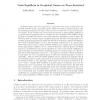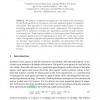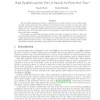SPAA
2006
ACM
15 years 7 months ago
2006
ACM
We consider a model of game-theoretic network design initially studied by Anshelevich et al. [2], where selfish players select paths in a network to minimize their cost, which is...
104
Voted
SIGECOM
2006
ACM
15 years 7 months ago
2006
ACM
Graphical games have been proposed as a game-theoretic model of large-scale distributed networks of non-cooperative agents. When the number of players is large, and the underlying...
111
click to vote
ICTAI
2006
IEEE
15 years 7 months ago
2006
IEEE
We propose a formulation of a general-sum bimatrix game as a bipartite directed graph with the objective of establishing a correspondence between the set of the relevant structure...
150
Voted
FOCS
2006
IEEE
15 years 7 months ago
2006
IEEE
We introduce a game theoretic model of network formation in an effort to understand the complex system of business relationships between various Internet entities (e.g., Autonomou...
112
Voted
FOCS
2006
IEEE
15 years 7 months ago
2006
IEEE
We advance significantly beyond the recent progress on the algorithmic complexity of Nash equilibria by solving two major open problems in the approximation of Nash equilibria an...
98
Voted
WINE
2007
Springer
15 years 7 months ago
2007
Springer
We present a computational approach to the saddle-point formulation for the Nash equilibria of two-person, zero-sum sequential games of imperfect information. The algorithm is a �...
99
Voted
ESA
2007
Springer
15 years 7 months ago
2007
Springer
Abstract. In this paper we consider Nash Equilibria for the selfish routing model proposed in [12], where a set of n users with tasks of different size try to access m parallel l...
117
Voted
FOCS
2007
IEEE
15 years 7 months ago
2007
IEEE
d Abstract) Kousha Etessami LFCS, School of Informatics University of Edinburgh Mihalis Yannakakis Department of Computer Science Columbia University We reexamine what it means to...
110
Voted
ISPDC
2008
IEEE
15 years 7 months ago
2008
IEEE
We consider the problem of computing all Nash equilibria in bimatrix games (i.e., nonzero-sum two-player noncooperative games). Computing all Nash equilibria for large bimatrix ga...
92
Voted
SAGT
2009
Springer
15 years 7 months ago
2009
Springer
We study Nash equilibria and the price of anarchy in the context of flows over time. Many results on static routing games have been obtained over the last ten years. In flows ov...





